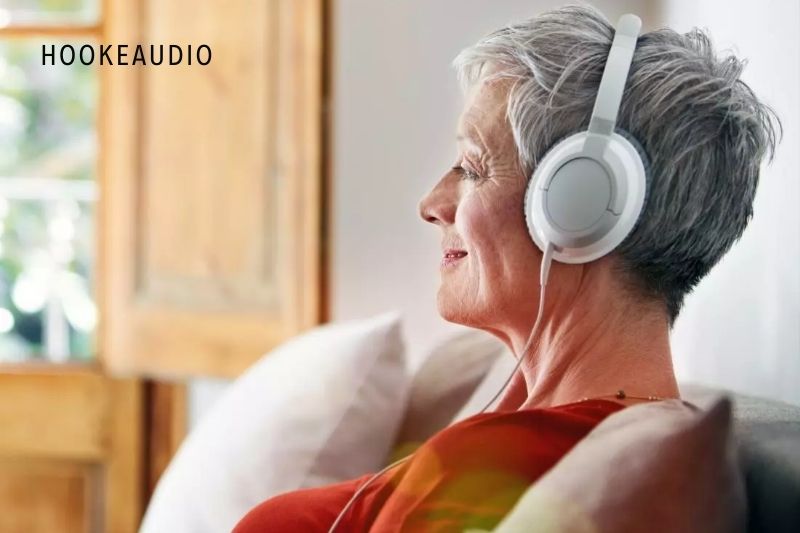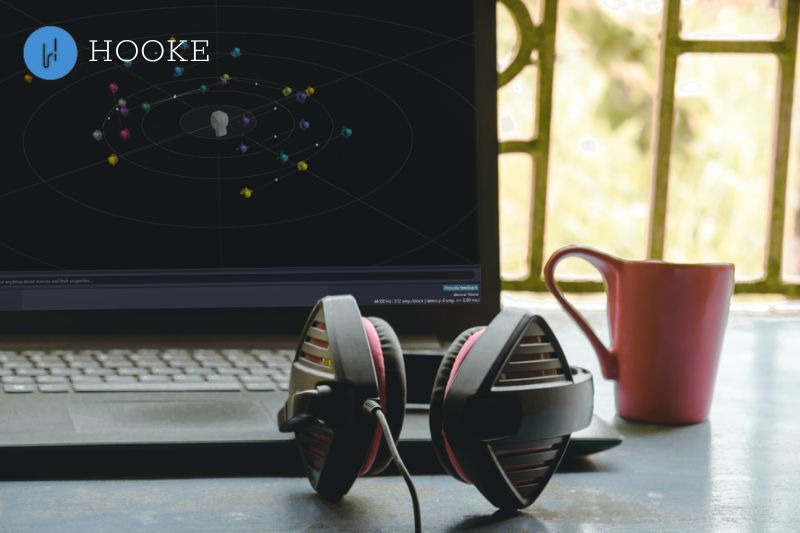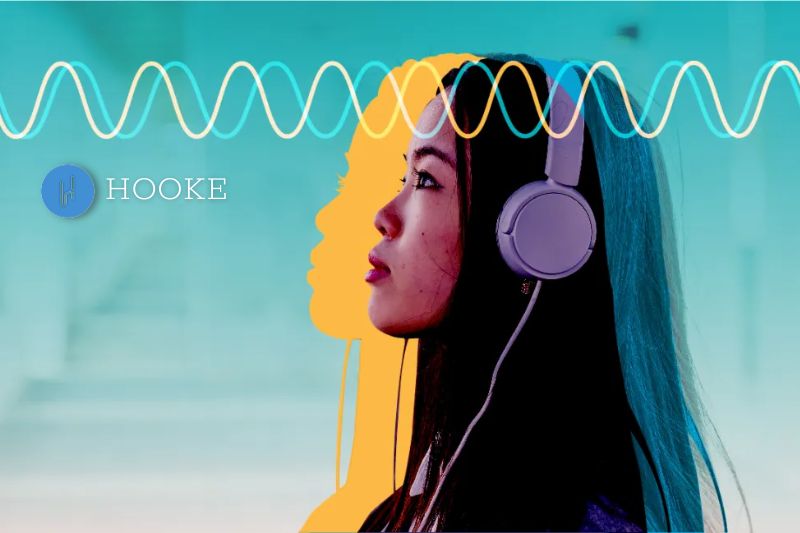Most people need to know the top search question on Google: What is Binaural Audio, exactly? Binaural audio is a type of 3D audio that creates an immersive sound experience. It is created by recording sounds from two different perspectives and then playing them back through headphones. This creates the auditory illusion of being in the same room as the sound source, making it ideal for gaming, movies, and music. Read more info at Hookeaudio.
Contents
- 1 What Is Binaural Sound (Binaural Beats)?
- 2 What is Binaural?
- 3 How Is A Binaural Mix Made?
- 4 What Do I Need To Listen To It?
- 5 Benefits of Binaural Audio
- 6 Different Types of Binaural Audio
- 7 Where to Find Binaural Audio Content
- 8 Common Misconceptions about Binaural Audio
- 9 What’s The Future Of Binaural Audio?
- 10 FAQ
- 11 Conclusion
What Is Binaural Sound (Binaural Beats)?

Binaural microphones are audio captured using a twin microphone system. Recording binaural sound engineers is to produce a 3D audio effect that replicates sound as though it is being heard live. Headphones are the best way to enjoy binaural recording. The term binaural translates to “having two ears.”
Binaural sound has been employed to produce more life-like listening experiences in music and entertainment since its development in the 1930s. Binaural recording is captured by placing two microphones at a distance equivalent to the distance between the ears of a human head.
Binaural delivers a layered user experience by distinguishing the position of one sound from the location of another. When sound arrives in one natural ear spacing before the other, the brain may determine the approximate position of a sound’s origin and discriminate directional sound.
Binaural beats and ASMRs (autonomous sensory meridian response)
Binaural recording is utilized in self-hypnosis and biofeedback activities in healthcare to generate certain brainwave states. Heinrich Wilhelm Dove, a Prussian physicist and meteorologist observed in 1839 that when two tones of different frequencies are transmitted to the left and right ears simultaneously, the brain sees a third tone that reflects the mathematical difference between the first two frequencies. The phenomenon is called entrainment, and the third tone is referred to as a binaural beat.
For example, when a 300 Hz sound frequency is delivered to the left ear and a 295 Hz frequency is transmitted to the right ear, the brain will analyze those two frequencies and experience a new frequency at 5 Hz. According to the researchers, listening to low-tone frequencies may calm down brain-wave activity, help the listener relax, and even ease pain in certain people.
Binaural beats are occasionally utilized to generate an autonomic sensory meridian response (ASMR) in virtual and augmented reality games. Binaural beats might be employed in this scenario to send chills down the player’s spine and provide a more involved playing experience.
What is Binaural?

The goal of binaural recording is to replicate the real-life experience of hearing sound.
Consider the last time you went to the movies: the action begins, and you immediately feel as if the sounds coming is flowing all around. The directors and sound designers are doing their best to immerse you in action by transmitting sounds via speakers strategically positioned around the theater.
Surround sound has been around for decades, but so has a lesser-known but equally effective technology that requires two audio channels.
The whole headphone restriction probably means that when it comes to experiences like going to see your favorite action movie, cutting-edge surround sound technology like Dolby Atmos is still where it’s at.
And how is it different from surround sound? We have the answers. To some extent, you already have access to binaural system. It’s simply a fancy way of describing how human ears beings normally hear sounds – ‘bi’ meaning two, and ‘aural’ referring to your human ears.
Please give me an earful: How binaural audio works.
One of the finest methods to capture binaural recording is using a “dummy head” – and yes, that is exactly what it sounds like. A composite rubber head holds two tiny microphones between its ears — it may even include a neck and torso.
These surfaces are significant to consider when considering how sound waves travel and bounce off various areas of the human body before reaching the eardrums. Some use a simpler technique, equipping a real person’s head with pair of headphones miniature microphones that fit inside the one ear like earbuds, but other systems rely only on modeled ear mics.
When you consider that everyone’s physique is different, there are undoubtedly some restrictions to the method and the equipment required. Everything from a person’s pinnae (the visible portion of the ear) to the size of their head shadow and shoulders can alter the final recording and how realistic it sounds.
If buying a dummy head is outside your budget, and you are looking for a fun DIY project, we’ve talked about how you can construct your own for a fraction of the price.
Playing it back
While there are several methods for producing convincing binaural recordings, there is only one true way to recreate them: a set of headphones. Our brains have evolved to determine the distance and position of sounds from everywhere around us based on variances in what each ear gets independently of the other. These discrepancies are known as interaural temporal and level disparities.
This sense would be entirely gone if we played a binaural recording over a pair of loudspeakers. Still, headphones preserve the same separation between the left and right channels to mimic our real-world experience.
How Is A Binaural Mix Made?
Binaural recordings are not a novel technique by any stretch of the imagination. They were initially shown in France in 1881 by a device called the Théâtrophone, which looked like two ancient horn-style telephones held against each ear – it played concerts or plays recorded over a chain of telephone receivers transmitters linked to the stage.
Fast forward nearly a century to the 1970s, when technology had progressed to produce more precise records. ‘Dummy heads,’ which looked like mannequins in each ear cavity, were utilized because they could account for additional factors such as vibrations inside the ear canal or sound reflection off the shoulders that exterior microphones couldn’t pick up.
When you listen to a binaural via headphones, your brain is easily duped into believing that an artificially created sound impression is coming from any place around you, above you, or below you.
What Do I Need To Listen To It?
The beauty of binaural microphone is that you don’t need any expensive equipment to enjoy it. Even a normal set of Apple EarPods (or AirPods) will be able to duplicate the impression. However, we would prefer choosing something a bit more advanced so that you can enjoy ‘natural’ sound waves with as much detail as possible.
LFE (Low-Frequency Effects), for example, are shifted a bit higher into the frequency range to guarantee they’re detectable, and the dynamic range is compressed a little more, so those using smartphones don’t have to crank up the volume to potentially harmful levels.
Finally, the more people who use better headphones, the greater the overall quality of binaural microphone will be – so start convincing your non-audiophile friends (if you have any!) to improve their gear.
Benefits of Binaural Audio

Binaural audio is a technique used to create a three-dimensional sound experience for listeners. This technology utilizes two microphones to capture sound from two different points of origin, combined to create a stereo sound perceived as coming from all around the listener. Here are some of the benefits of binaural audio:
Immersive sound experience
Binaural audio creates a sense of immersion that cannot be achieved with traditional stereo audio. It simulates the natural way our ears hear the sound, which makes the audio feel like it is coming from all around us.
Increased engagement
Binaural audio can increase engagement with audio content. The immersive sound experience creates a deeper connection between the listener and the audio content, making it more memorable and enjoyable.
Better understanding
Binaural audio can be used to improve understanding in situations where audio quality is poor or when there is background noise. The binaural effect helps to separate the audio signals, making it easier for the listener to distinguish and understand the audio.
Improved learning
Binaural audio can be used to enhance learning. By creating a more engaging and immersive audio experience, learners are more likely to retain information and remember what they have learned.
Stress reduction

Binaural audio has been shown to have a calming effect on the listener. It can be used to create relaxing audio experiences, such as guided meditations or soundscapes, that can help reduce stress and anxiety.
Enhanced entertainment
Binaural audio can enhance entertainment experiences, such as video games or virtual reality. The immersive sound experience creates a more realistic and engaging audio environment, making the entertainment experience more enjoyable.
Accessibility
Binaural audio can be used to improve accessibility for people with hearing impairments. Binaural audio can create a more inclusive audio experience for all listeners by simulating the natural way our ears hear the sound.
Creative expression
Binaural audio can be used as a creative tool for artists and musicians. It allows them to create unique and immersive soundscapes that transport the listener to different environments or create emotional responses.
Different Types of Binaural Audio

There are different types of binaural audio, each with its approach and benefits. Here are some of the most common types of binaural audio:
Ambisonics
Ambisonics is binaural audio that uses a spherical microphone array to capture sound from all directions. The sound is then processed and combined to create a 3D sound experience. Ambisonics can be used for live events or recording and is compatible with various playback formats.
3D Audio
3D audio is binaural audio that uses advanced algorithms to create a realistic 3D sound experience. This technology uses head tracking to adjust the sound according to the listener’s head movements, creating an immersive experience. 3D audio can be used for gaming, virtual reality, and other immersive applications.
Dummy Head Recording
Dummy head recording is a type of binaural audio that uses a microphone system that resembles the shape and size of a human head. The sound is captured as if it were heard by a person, creating a realistic 3D sound experience. Dummy head recording is often used for music production and sound design.
Holophonic Sound
Holophonic sound is binaural audio that uses a specific recording technique to create a 3D sound experience. This technology uses a specific recording technique that captures the sound as it would be heard by a person, creating a realistic 3D sound experience. Holophonic sound is often used for sound effects and music production.
Spatial Audio
Spatial audio is binaural audio that uses various techniques to create a realistic 3D sound experience. This technology can simulate various sound environments, such as concert halls, movie theaters, or outdoor spaces. Spatial audio is often used for music production, sound design, and virtual reality applications.
Binaural Beats
Binaural beats are audio that uses two different frequencies played simultaneously to create a specific brainwave pattern. This technology is often used for relaxation, meditation, and sleep therapy.
Where to Find Binaural Audio Content

If you are interested in exploring this technology, here are some places where you can find binaural audio content:
Music streaming services
Many music streaming services, such as Tidal and Qobuz, offer binaural audio content. These platforms offer a variety of music genres and artists that have been recorded or remastered using binaural audio technology.
Podcasts
Some podcasts use binaural audio to create an immersive experience for their listeners. These podcasts cover various topics, such as storytelling, meditation, and ASMR, and can be found on various platforms, such as Spotify and Apple Podcasts.
Virtual reality applications
Virtual reality applications use binaural audio to create a realistic 3D sound experience for users. These applications can be found on various platforms, such as Oculus and Steam, and offer various experiences, such as games, simulations, and educational content.
Sound libraries
Sound libraries, such as the Free Sound Project and Soundly, offer a wide range of binaural audio content that can be used for sound design, music production, and other creative projects. These libraries offer a variety of sound effects, ambient recordings, and music tracks that have been recorded using binaural audio technology.
YouTube channels
Many YouTube channels use binaural audio to create immersive experiences for their viewers. These channels cover various topics, such as travel, relaxation, and gaming, and can be found searching for binaural audio or ASMR on the platform.
Audio books
Some audio books use binaural audio to create a more immersive listening experience. These books cover various genres, such as fiction and non-fiction, and can be found on various platforms, such as Audible and Apple Books.
Live events
Some live events, such as concerts and theater performances, use binaural audio to create a more immersive experience for their audience. These events can be found by searching for binaural audio or 3D audio on event platforms, such as Eventbrite and Ticketmaster.
Common Misconceptions about Binaural Audio

Binaural audio is a technology that creates a 3D sound experience for the listener by using two microphones to capture sound from two different points of origin. While this technology has gained popularity in recent years, there are still some misconceptions surrounding it.
3D Audio vs Surround Sound
One of the most common misconceptions about binaural audio is that it is the same as surround sound. While both technologies aim to create a more immersive sound experience, they use different techniques to achieve this goal.
Surround sound uses multiple speakers around a room to create a 3D sound experience. In contrast, binaural audio uses two microphones to capture sound from two different points of origin, creating a more natural and immersive sound experience.
Monaural vs Binaural Audio
Another common misconception about binaural audio is that it is the same as monaural audio. Monaural audio is a sound played through a single channel or speaker. In contrast, binaural audio uses two channels or speakers to create a more realistic 3D sound experience.
What’s The Future Of Binaural Audio?
Binaural audio has an apparent use in virtual reality, a medium growing in popularity as the range of headgear available from computer firms develops. The Samsung Galaxy Gear, Google Daydream, Oculus Rift, PlayStation VR, and HTC Vive have all launched a wave of VR content that is set to increase.
And, of course, if you move your head closer to a sound in a virtual-reality setting, you want that sound to get louder – if it doesn’t, you’ll lose the all-important immersion that sells a virtual-reality experience. It remains to be seen if VR will become more acceptable to the ordinary user.
While virtual reality is growing more popular, the number of individuals who use it and might benefit from binaural audio is still small. The point of entry normally demands either a gaming interest or a strong PC setup, and although Netflix (shown above), Sky, and Google have made measures to make it more accessible, there’s still a long way to go.
Nonetheless, whether it comes through virtual reality, streaming services, or plain old-fashioned vinyl, the development of new binaural goods is something to keep an eye (or, maybe, ear) out for.
Read more:
- How to Make Binaural Audio? Top Full Guide For You 2023
- How To Record Binaural 3D Audio to ANY Device (Android, iPhone, GoPro, DSLR, Field Recorder, Computer, 360Camera)
FAQ
Do binaural sounds truly work?
Binaural beats, described, are an illusion. According to Hector Orozco Perez, author of new research on the mystery beats, when you listen to two pure tones divided into each ear, the little variation generates a “frequency mismatch” when the sound travels to the auditory section of the brainstem.
Can binaural beats be harmful?
Consequences of listening to Bina
While there are no potential risks to beats, you must ensure that the tone interaural level differences are not too high. Loud noises at or over 85 dB may cause hearing damage in the long term.
How long should you listen to binaural beats?
Listening to beats in a quiet, distraction-free environment is preferable. Listening to the binaural beat audio in your headphones for at least 30 minutes each day guarantees that the rhythm is entrained (has fallen into synchronicity) throughout the brain.
What are digital drugs?
Digital drugs, or beats, are considered capable of modifying brain wave patterns and generating an altered state of consciousness comparable to that produced by narcotics or profound meditation.
Conclusion
If you’re looking for a way to improve your audio experience, you may want to consider binaural audio. This type of audio can provide several benefits, including improved sound quality and a more immersive listening experience.

